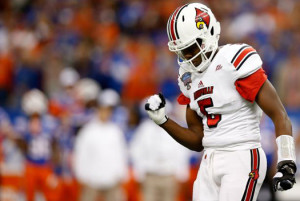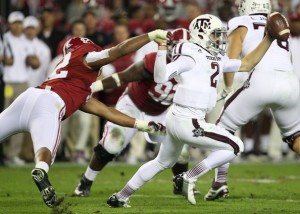Sometimes, it’s hard to believe that it’s 2014. With draft season now in full gear, I wanted to take a few minutes and look at the stats of the top college quarterbacks from last year. Unfortunately, that’s easier said than done. I couldn’t find a site that presented a full list of all college quarterback stats, including sacks, which is, of course, insane.
College football records sacks as rushing plays for the offense; as a result, knowing how many sacks Johnny Manziel or Teddy Bridgewater took last year is not that easy to find. So here’s what I did:
1) Using team game log data, I found the number of sacks for each defense in each game.
2) Next, I recorded the percentage of team pass attempts recorded by each quarterback for his offense in each game (usually close to 100%).
3) I synched up these two sets of data, and multiplied each quarterback’s percentage of team pass attempts by the number of sacks by his opponent’s defense in that game.
That provided me with some useful estimated sack data. From there, I calculated each quarterback’s Adjusted Net Yards per Attempt average, which is simply (Gross_passing_yards + 20*PassTDs – 45*INTs – Estimated_sack_yards_lost) / (Pass_attempts + Estimated_sacks). I did this for the 140 quarterbacks with the most pass attempts in the FBS (sorry, Jimmy Garoppolo fans) in 2013.
Since the number of pass attempts vary wildly at the college level, I also calculated a Value Over Average statistic. The 140 quarterbacks had an average ANY/A of 6.44, so the Value metric (which is what the table is sorted by) is simply (ANY/A – 6.44) * (Pass_attempts + Estimated_sacks). Here’s how to read Bridegwater’s line, the Louisville quarterback who many believe will be the first quarterback selected in the draft.
Bridgewater provided the 5th most passing value by this formula, completing 303 of 427 passes for 3,970 yards with 31 touchdowns and 4 interceptions. He took 25.5 sacks and lost 185 yards, and had a sack rate of 6% (if I included the percent sign, the table would not sort correctly). Bridgewater also averaged 13.1 yards per completion and had a 9.34 ANY/A average, which combined with his number of dropbacks, means he added 1,310 adjusted net yards of value over average. By default, the table below only shows the top 25, but you can sort and/or search to find each of the 140 quarterbacks (and you can change the number of quarterbacks displayed via the dropdown box to the left).
If you believe in the power of internet mock drafts, the top quarterback prospects are Bridgewater, Manziel, and Blake Bortles, with Fresno State’s Derek Carr a bit behind that group. After Carr comes the SEC trio of Zach Mettenberger, A.J. McCarron, and Aaron Murray. How do those seven quarterbacks compare statistically? Each rank in the top 15, but they got there in very different ways.
The table below shows how each quarterback fared relative to this group of seven quarterbacks in each of the main passing statistics. For each quarterback I’ve included his percentage relative to the group of quarterbacks, which I calculated by dividing each passer’s rate for each statistic by the group average rate. In all cases, greater than 100% means more than average, so for interceptions and sacks, a higher percentage is a bad thing.
Bridgewater
Bridgewater fares really well in this analysis, which is to be expected. He had the best completion percentage and fared very well in most of the important categories. His interception rate was obviously outstanding, although we all know that interception rates are not particularly sticky. If there’s a knock on Bridgewater’s game, it’s that he does not have a great deep ball, and that’s reflected here by his below-average (for this group) yards per completion average. Of course, with all statistics, context is key, and Bridgewater’s numbers here (including the low YPC average) may simply reflect Louisville’s offensive philosophy, and not Bridgewater’s particular game. The other concern would be Bridgewater’s sack rate, which as pointed out by Dave Archie, the worst of this group. I haven’t heard any scouts bring up Bridgewater’s poor sack rate, but that is a potential red flag.
Bortles
While Bortles has an average ANY/A rate for this group, it’s not too hard to find some red flags if you’re looking for them. Despite playing in the American Conference, he threw just 25 touchdowns. Bortles did run for 6 himself and his running back Storm Johnson ran for 14 touchdowns, but that is still a pretty low number. Central Florida was a good but not great team in 2013 once you adjust for strength of schedule, and the Golden Knights ranked only 30th in points scored. This can be a function of conservative coaching, but it’s not as though Bortles was throwing for three touchdowns every week.
Borles also came in below average in the attempts department. He can’t control how often his team passes — especially when UCF usually had a lead and the team went 12-1 — but it’s not as though the other quarterbacks on this list were on bad teams. It just feels a little odd to me that he was not off the charts in either efficiency or attempts, which is usually what a quarterback from a non-power conference needs to do to get recognized. Perhaps the better way to look at this is to praise scouts for elevating a player who I think statistically would not be considered a top-five pick.
The other questionable area for Bortles is when it comes to taking sacks. A 5.5% sack rate is not unreasonably high, but when picking nits on the top quarterbacks, that stands out. One would expect a lower rate for a quarterback playing against weaker competition who generally played with the lead.
Manziel
The interception rate jumps out at you, although again, I’m not too concerned with one season of double-digit interceptions (one reason why: five of them bounced off his receiver’s hands). Manziel had a good sack rate and threw for a lot of yards: he ranked 6th in the country in ANY/A, but he jumps Mariota and Bridgewater and ranks 4th in plain old NY/A, which is the more predictive statistic. Despite the crazy highlights, Manziel was not a boom-or-bust quarterback, as evidenced by his 69.9% completion rate. He led the SEC in completion percentage in each of his two seasons, and his completion percentage last year was the 2nd best by any SEC quarterback since 2000 (although that may not be quite as impressive as it sounds). Finally, here’s a fun review of Manziel’s game by Matt Waldman.
Carr
Carr’s numbers are off the charts here, which serve as a good reminder for how different his situation was compared to the other passers. He played in a super high volume offense, which led to him finishing with the 2nd most pass attempts of any passer in college football in 2013. And he had the lowest sack rate of any of the 140 passers on the list, an incredibly impressive accomplishment… until you realize the circumstances. Carr was mostly dinking and dunking, as you can see by his low yards per completion average. He played an easy schedule, but then again, so did Bridgewater and Bortles. The scouts are not super high on Carr, and I think it’s understandable to take a lot of his insane numbers (50 touchdowns!) with a grain or two of salt. Honestly, I don’t really know what to do with his numbers, but I’m inclined to trust the skeptical scouts on this one.
Mettenberger
One thing immediately jumps out at you with Mettenberger: he averaged an incredible 16.0 yards per completion, a number only topped by Bryce Petty’s scorched-earth offense at Baylor. Mettenberger is your classic 1960s AFL quarterback: he’s 6’5, 230, and likes to throw deep. He’ll take some sacks because he’s going for the big play, but he’s a good fit for teams looking for a gun-slinger. On the other hand, it’s important to remember that his situation played into that impressive yards per completion average. LSU was a run-heavy team with a run-heavy reputation, which can make throwing deep a lot easier on the quarterback. Mettenberger had as many games with 30+ pass attempts (3) as games with fewer than 20 pass attempts.
McCarron
My thoughts on McCarron are summed up here.
Murray
Murray ranked as my top statistical quarterback of 2012 after adjusting for strength of schedule. If I have the time, I’ll do the same thing for the 2013 stats, which would presumably help Murray (and McCarron and Mettenberger) again. Murray has a good sack rate but doesn’t stand out as special anywhere else. Statistically he was stronger as a junior, but the knock on him is that he is not a special quarterback. He’s not an elite athlete, he’s short, and he’s not hyper-accurate. He’s intelligent and he’s experienced, but that’s not enough to be picked in the first three rounds. Like McCarron, Murray was not operating in a pass-first offense. As a result, some of their gross numbers underwhelm, but each passer did produce strong ANY/A numbers. Murray has the edge in sack rate, while McCarron has the better completion percentage and interception rate.
It should go without saying that stats for college quarterbacks don’t come close to telling the whole story. But they’re a part of the story, and they should at least be properly recorded and available for people to use as references.


